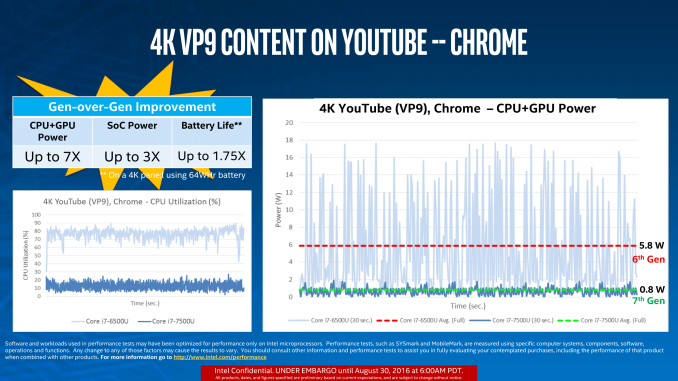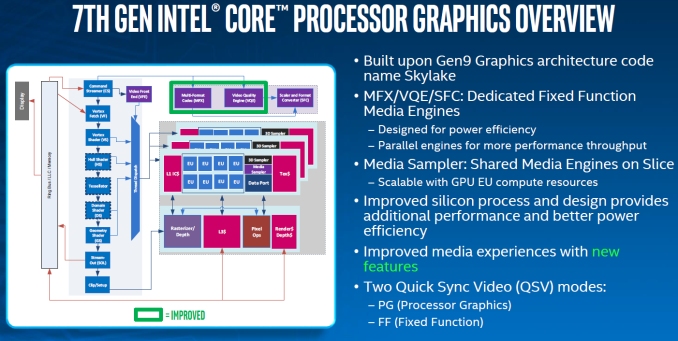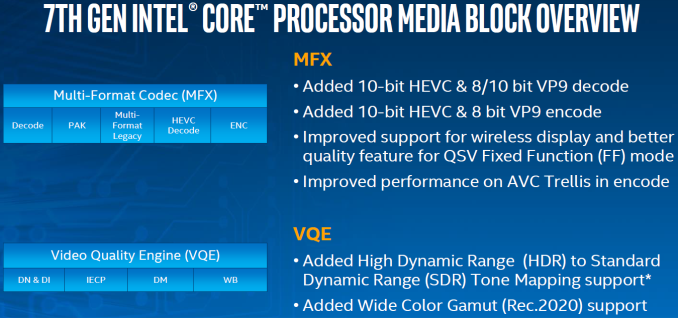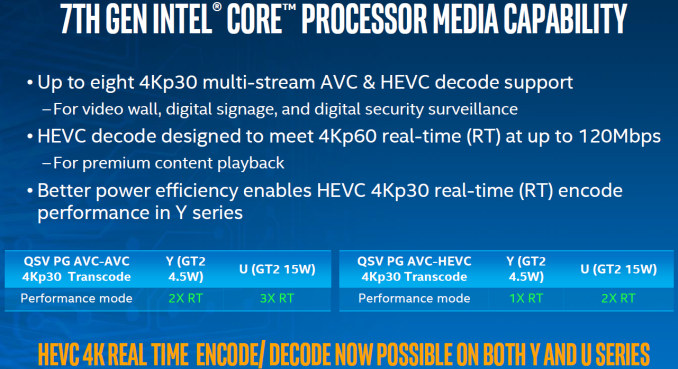Intel Announces 7th Gen Kaby Lake: 14nm PLUS, Six Notebook SKUs, Desktop coming in January
by Ganesh T S & Ian Cutress on August 30, 2016 9:00 AM EST- Posted in
- CPUs
- Intel
- 14nm
- Kaby Lake
- Gen 9
- Speed Shift
- Turbo Boost
The Kaby Lake-U/Y GPU - Media Capabilities
While from a feature standpoint Kaby Lake is not a massive shift from Skylake, when it comes to GPU matters it none the less brings across some improvements that are directly visible to the end-user. As with the CPU cores, Intel’s 14nm+ process will allow for higher GPU frequencies and overall better GPU performance, but arguably the more impressive change with Kaby Lake is the updated media capabilities. To be clear, Kaby Lake is still an Intel Gen9 GPU – the core GPU architecture has not changed – but Intel has revised the video processing blocks to add further functionality and improve their performance for Kaby Lake.
The media capabilities of the Skylake GPU was analyzed in great detail in our 2015 IDF coverage. The updates to Kaby Lake-U/Y should be analyzed while keeping those features in mind. The major feature change in the Kaby Lake-U/Y media engine is the availability of full hardware acceleration for encode and decode of 4K HEVC Main10 profile videos. This is in contrast to Skylake, which can support HEVC Main10 decode up to 4Kp30, but does so using a “hybrid” process that spreads out the workload over the CPU, the GPU’s media processors, and the GPU’s shader cores. As a result, not only can Kaby Lake process more HEVC profiles in fixed function hardware than before, but it can do so at a fraction of the power and with much better throughput.
Also along these lines, Kaby Lake has implemented full fixed function 8-bit encode and 8/10-bit decode support for Google’s VP9 codec. Skylake offered hybrid decode support for the codec, which is useful from a feature standpoint, but is a bit more problematic in real-world use since it’s not as power-efficient to use VP9 a codec implemented in fixed function hardware. Google has proven eager to serve up VP9 to its YouTube users, so they can now much more efficiently decode the codec. Meanwhile, on the encode side, brand-new to Kaby Lake is VP9 encoding support, to go with the aforementioned HEVC encode support.
| Intel Video Codec Support | |||||
| Kaby Lake | Skylake | Broadwell | |||
| H.264 Decode | Hardware | Hardware | Hardware | ||
| HEVC Main Decode | Hardware | Hardware | Hybrid | ||
| HEVC Main10 Decode | Hardware | Hybrid | No | ||
| VP9 8-Bit Decode | Hardware | Hybrid | Hybrid | ||
| VP9 10-Bit Decode | Hardware | No | No | ||
| H.264 Encode | FF & PG-Mode | FF & PG-Mode | PG-Mode | ||
| HEVC Main Encode | FF & PG-Mode | PG-Mode | No | ||
| HEVC Main10 Encode | FF & PG-Mode | No | No | ||
| VP9 8-Bit Encode | FF & PG-Mode | No | No | ||
| VP9 10-Bit Encode | No | No | No | ||
An overview of the GPU engine in Kaby Lake-U/Y is presented in the slide below.
The new circuitry for hardware accelerating HEVC Main10 and VP9 are part of the MFX block. The MFX block can now handle 8b/10b HEVC and VP9 decode and 10b HEVC / 8b VP9 encode. The QuickSync block also gets a few updates to improve quality further, and AVC encode performance also receives a boost.
The Video Quality Engine also receives some tweaks for HDR and Wide Color Gamut (Rec.2020) support. Skylake's VQE brought in RAW image processing support with a 16-bit image pipeline for selected filters. While Intel has not discussed the exact updates that enable Rec.2020 support, we suspect that more components in the VQE can now handle higher bit-widths. Intel pointed out that the HDR capabilities involve usage of both the VQE and the EUs in the GPU. So, there is still scope for further hardware acceleration and lower power consumption in this particular use-case.
Intel claims that Kaby Lake-U/Y can handle up to eight 4Kp30 AVC and HEVC decodes simultaneously. HEVC decode support is rated at 4Kp60 up to 120 Mbps (especially helpful for premium content playback and Ultra HD Blu-ray). With Kaby Lake-U/Y's process improvements, even the 4.5W TDP Y-series processors can handle real-time HEVC 4Kp30 encode.
On the subject of premium content, in their presentation Intel rather explicitly mentioned that the improved decode capabilities were, in part, for “premium content playback.” When we pushed Intel a bit on the matter – and specifically on 4K Netflix support – they didn’t have much to say beyond the fact that to play 4K Netflix, you need certification. Based on what was said and what was not said (and what we know about the certification process) our educated guess is that the updates in Kaby Lake-U/Y include some new DRM requirements for 4K content, and 4K Netflix should hopefully be good to go with the new platform. However on that note, because of those DRM requirements and that this is being pitched as a new feature for Kaby Lake, we suspect that when 4K Netflix streaming does come to the PC platform, Skylake owners are going to be out of luck.
Update: On a related note, one of the Intel press releases that has gone out today is that Sony's 4K movie and television streaming service, ULTRA, will be coming to Kaby Lake PCs in 2017. To date the service has only been available on Sony's televisions - in part for security reasons - so this is an example of one such premium content service that's coming to Kaby Lake thanks to its stronger DRM abilities.
It must be kept in mind that all the encode / decode aspects discussed above are for 4:2:0 streams. This is definitely acceptable for consumer applications, as even Blu-ray video streams (that have plenty of bandwidth at their disposal) are encoded in 4:2:0. However, if Intel wants to use the new media engine in professional broadcast and datacenter applications, 4:2:2, and, to a much lesser extent, even 4:4:4 support might become necessary. For the purpose of the Kaby Lake-U/Y consumer platforms being introduced today, this is not an issue at all.
Moving on, like the GPU core itself, Kaby Lake-U/Y's display pipeline is the same as that of Skylake. This means the iGPU can support up to three simultaneous displays.

One of the disappointing aspects from Skylake that has still not been addressed in Kaby Lake-U/Y is the absence of a native HDMI 2.0 port with HDCP 2.2 support. Intel has been advocating the addition of an LSPCon (Level Shifter - Protocol Converter) in the DP 1.2 path. This approach has been used in multiple motherboards and even SFF PCs like the Intel Skull Canyon NUC (NUC6i7KYK) and the ASRock Beebox-S series. Hopefully, future iterations of Kaby Lake (such as the desktop and high-performance mobile parts coming in January) address this issue to simplify BOM cost for system vendors.
In summary, Kaby Lake-U/Y resolves one of the major complaints we had about Skylake's media engine: the absence of hardware-accelerated 4Kp60 HEVC Main10 decode. There are a few other improvements under the hood that enable a more satisfying multimedia experience for consumers. The software and content-delivery ecosystems have plenty of catching up to do when it comes to taking full advantage of Kaby Lake-U/Y's media capabilities.














129 Comments
View All Comments
tipoo - Tuesday, August 30, 2016 - link
There was a Zen iMac APU rumor, but I doubt the Macbooks would get it unless AMD pulled a real coup with Zen power draw.KPOM - Tuesday, August 30, 2016 - link
New MacBook Pros are expected in October, though. Those would be Skylake unless Apple has plans to use the 4.5W chips TDP upped to 7W, which I highly doubt (maybe in an updated MacBook Air, but I doubt that the Air will get an update).nils_ - Thursday, September 8, 2016 - link
Seems Apple hasn't announced any new Macbook Pros... On the other hand, they probably get a lot more profit on selling outdated hardware.BillBear - Tuesday, August 30, 2016 - link
According to Paul Thurrott, Microsoft was not at all happy with the general bugginess of Skylake.>while Intel has never formally confirmed this, my sources at Microsoft and elsewhere have told me that Skylake, the original “tock” release following Broadwell, was among the buggiest of chipsets that Intel has ever released. Problems with Skylake are at the heart of most of the issues that Microsoft has seen with its Surface Pro 4 and Surface Book devices, and it’s fair to say that the software giant now regrets delivering the very first Skylake-based devices into the market in late 2015.
https://www.thurrott.com/hardware/73161/intel-star...
KPOM - Tuesday, August 30, 2016 - link
So don't expect them to rush out a Surface Pro 5 or Surface Book 2 until they are comfortable there are no bugs?iwod - Wednesday, August 31, 2016 - link
As much as I dislike Apple's ways, sometimes they do things for a reason.Not sometimes, but EVERYTHING. With Apple, if you dont understand why they did something, it is highly likely you overlook rather then something they skip over.
lilmoe - Saturday, September 3, 2016 - link
Everyone does everything for a "reason". Most times than not, I don't like those reasons.I should have clarified; sometimes they do things for a *good* reason. Keyword here is "sometimes", IMO.
jhoff80 - Tuesday, August 30, 2016 - link
Interesting that it says that 4k resolution support is new on Skylake and also requires additional cooling, considering I have a tablet from Cube in China that is a Skylake Core M, fanless, and supports 4k over USB-C/DisplayPort Alternate Mode. Though then again, based on what I'm looking at in the UEFI settings, it doesn't appear like Cube followed any of Intel's guidelines either.jhoff80 - Tuesday, August 30, 2016 - link
Wait, I confused myself a little there thinking it said new on Kaby Lake. Just the additional cooling part is weird though.rogelio - Tuesday, August 30, 2016 - link
@ Ian Cutress & Ganesh T SI'm a little confused by the below, can you clarify:
One of the disappointing aspects from Skylake that has still not been addressed in Kaby Lake-U/Y is the absence of a native HDMI 2.0 port with HDCP 2.2 support
My understanding was that retail solution releases of Kaby lake (e.g. the forthcoming Kaby Lake NUC) would have HDMI 2.0 (not 1.4) support natively. Do you mean that the only way to gain HDMI 2.0 support is to use a converted on the DP 1.2 port? If so, I thought current manufacturers of converters are limited in color bit depth and can't do true 4k 60hz at full color depth.